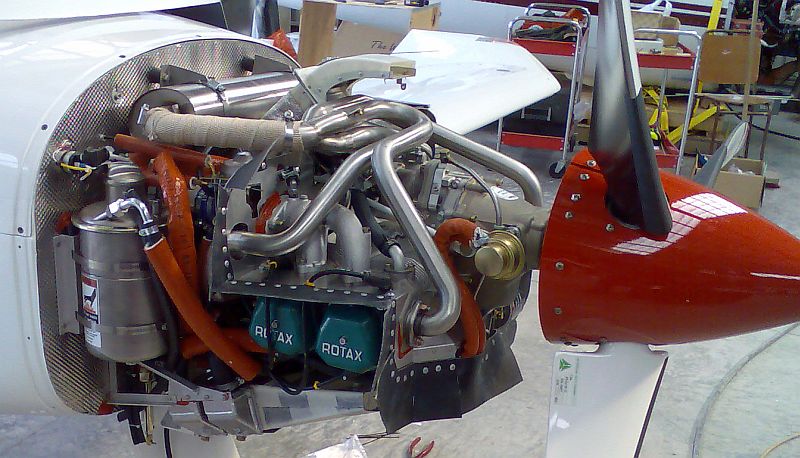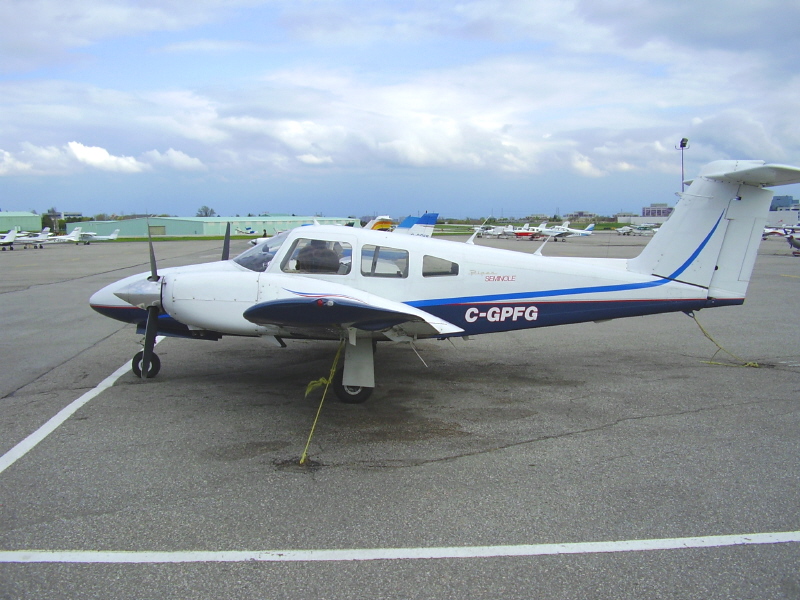|
Aeronca Sedan
The Aeronca 15AC Sedan is a four-seat, fixed conventional gear light airplane which was produced by Aeronca Aircraft between 1948 and 1951. Designed for personal use, the Sedan also found applications in utility roles including bush flying. The Sedan was the last design that Aeronca put into production and was the largest aircraft produced by the company. Design and development Like those of other Aeronca designs, the Sedan's fuselage and tail surfaces are constructed of welded metal tubing. The outer shape of the fuselage is created by a combination of wooden formers and longerons, covered with fabric. The cross-section of the metal fuselage truss is triangular, a design feature which can be traced back to the earliest Aeronca C-2 design of the late 1920s. In a significant design departure from previous Aeronca aircraft, the strut-braced wings of the Sedan are all-metal assemblies. Such combinations of construction types were not common. While the Sedan mated a fabric-cove ... [...More Info...] [...Related Items...] OR: [Wikipedia] [Google] [Baidu] |
WikiProject Aircraft
A WikiProject, or Wikiproject, is a Wikimedia movement affinity group for contributors with shared goals. WikiProjects are prevalent within the largest wiki, Wikipedia, and exist to varying degrees within Wikimedia project, sister projects such as Wiktionary, Wikiquote, Wikidata, and Wikisource. They also exist in different languages, and translation of articles is a form of their collaboration. During the COVID-19 pandemic, CBS News noted the role of Wikipedia's WikiProject Medicine in maintaining the accuracy of articles related to the disease. Another WikiProject that has drawn attention is WikiProject Women Scientists, which was profiled by ''Smithsonian Magazine, Smithsonian'' for its efforts to improve coverage of women scientists which the profile noted had "helped increase the number of female scientists on Wikipedia from around 1,600 to over 5,000". On Wikipedia Some Wikipedia WikiProjects are substantial enough to engage in cooperative activities with outside organization ... [...More Info...] [...Related Items...] OR: [Wikipedia] [Google] [Baidu] |
Tailwheel
Conventional landing gear, or tailwheel-type landing gear, is an aircraft undercarriage consisting of two main wheels forward of the center of gravity and a small wheel or skid to support the tail.Crane, Dale: ''Dictionary of Aeronautical Terms, third edition'', page 133. Aviation Supplies & Academics, 1997. From the Ground Up, 27th edition, page 11 The term taildragger is also used, although some argue it should apply only to those aircraft with a tailskid rather than a wheel. The term "conventional" persists for historical reasons, but all modern jet aircraft and most modern propeller aircraft use tricycle gear. History In early aircraft, a tailskid made of metal or wood was used to support the tail on the ground. In most modern aircraft with conventional landing gear, a small articulated wheel assembly is attached to the rearmost part of the airframe in place of the skid. This wheel may be steered by the pilot through a connection to the rudder pedals, allowing the rudder ... [...More Info...] [...Related Items...] OR: [Wikipedia] [Google] [Baidu] |
Aeronca 11 Chief
The Aeronca Chief is a single-engine, light aircraft with fixed conventional landing gear and two seats in side-by-side configuration, which entered production in the United States in 1945. Designed for flight training and personal use, the Chief was produced in the United States between 1946 and 1950. The Chief was known as a basic gentle flyer with good manners, intended as a step up from the 7AC Champion which was designed for flight training. Like many classic airplanes, it has a significant adverse yaw, powerful rudder and sensitive elevator controls. It had a well-appointed cabin, with flocked taupe sidewalls and a zebra wood grain instrument panel. There was never a flight manual produced for the 11AC or 7AC series airplanes, as a simple placard system was deemed enough to keep a pilot out of trouble. Production history The model 11 Chief was designed and built by Aeronca Aircraft Corporation. While it shared the name "Chief" with the pre-war models, the design was ... [...More Info...] [...Related Items...] OR: [Wikipedia] [Google] [Baidu] |
Aeronca Champion
The Aeronca Model 7 Champion, commonly known as the "Champ", or "Airknocker",Bellanca Aircraft Corp, " d: "The Champ only $4,995"" ''Flying Annual & Pilots' Guide,'' 1971 ed., pp.36–37 iff-Davis NY is a single-engine light airplane with a high wing, generally configured with fixed conventional landing gear and tandem seating for two occupants. Designed for flight training''Flying'' Dec. 1946, as quoted in ''Flying Annual & Pilots' Guide,' 1971 ed. iff-Davis NY' and personal use—and specifically developed to compete with the popular Piper Cub. It entered production in the United States in 1945, spawning one of the most popular, and longest-produced, light airplane models in the world."he Big 10" (planes in production longest) sidebar, ''Air & Space Smithsonian'' Feb. 1996, vol.10#6, p.48.Wilkinson, Stephan,First Flight: The Champ" ''Flying,'' February 1971: iff-Davis NY, as retrieved 2016-01-30 from Google Books, and as reproduced in print edition of ''Flying Annual & P ... [...More Info...] [...Related Items...] OR: [Wikipedia] [Google] [Baidu] |
Cowling
A cowling is the removable covering of a vehicle's engine, most often found on automobiles, motorcycles, airplanes, and on outboard boat motors. On airplanes, cowlings are used to reduce drag and to cool the engine. On boats, cowlings are a cover for an outboard motor. In addition to protecting the engine, outboard motor cowlings need to admit air while keeping water out of the air intake. Etymology "Cowling" comes from "cowl", which originated from Middle English coule, from Old English cūle, from earlier cugele (“hood, cowl”). This, in turn, came from Ecclesiastical Latin cuculla (“monk's cowl”), from Latin cucullus (“hood”), of uncertain origin. In aviation In aviation, a cowling may be used for drag reduction or engine cooling by directing airflow. Examples in aviation include the NACA cowling and Townend ring. On an airplane, the cowling may also cover part of the fuselage, the nacelles, the engine mount and part of the cockpit.Aviation Machinist's Mates' Ma ... [...More Info...] [...Related Items...] OR: [Wikipedia] [Google] [Baidu] |
Constant Speed Propeller
In aeronautics, a variable-pitch propeller is a type of propeller (airscrew) with blades that can be rotated around their long axis to change the blade pitch. A controllable-pitch propeller is one where the pitch is controlled manually by the pilot. Alternatively, a constant-speed propeller is one where the pilot sets the desired engine speed ( RPM), and the blade pitch is controlled automatically without the pilot's intervention so that the rotational speed remains constant. The device which controls the propeller pitch and thus speed is called a propeller governor or constant speed unit. Reversible propellers are those where the pitch can be set to negative values. This creates reverse thrust for braking or going backwards without the need to change the direction of shaft revolution. Some aircraft have ground-adjustable propellers, however these are not considered variable-pitch. These are typically found only on light aircraft and microlights. Purpose When an aircraft is ... [...More Info...] [...Related Items...] OR: [Wikipedia] [Google] [Baidu] |
Lycoming O-360
The Lycoming O-360 is a family of four-cylinder, direct-drive, horizontally opposed, air-cooled, piston aircraft engines. Engines in the O-360 series produce between 145 and 225 horsepower (109 to 168 kW), with the basic O-360 producing 180 horsepower. The engine family has been installed in thousands of aircraft, including the Cessna 172, Piper Cherokee/Archer, Grumman Tiger, and many home-built types. It has a factory rated time between overhaul (TBO) of 2000 hours or twelve years. O-360 family engines are also widely used in airboats, most notably in the Hurricane Aircats used by the US Army during the Vietnam War. The first O-360 certified was the A1A model, certified on 20 July 1955 to United States CAR 13 effective March 5, 1952 as amended by 13-1 and 13-2. The Lycoming IO-390 is an O-360 which has had its cylinder bore increased by , developing . Series The O-360 family of engines comprises 167 different models with 12 different prefixes. All have a disp ... [...More Info...] [...Related Items...] OR: [Wikipedia] [Google] [Baidu] |
Seaplane
A seaplane is a powered fixed-wing aircraft capable of takeoff, taking off and water landing, landing (alighting) on water.Gunston, "The Cambridge Aerospace Dictionary", 2009. Seaplanes are usually divided into two categories based on their technological characteristics: floatplanes and flying boats; the latter are generally far larger and can carry far more. Seaplanes that can also take off and land on airfields are in a subclass called amphibious aircraft, or amphibians. Seaplanes were sometimes called ''hydroplanes'', but currently this term applies instead to Hydroplane (boat), motor-powered watercraft that use the technique of Planing (boat), hydrodynamic lift to skim the surface of water when running at speed. The use of seaplanes gradually tapered off after World War II, partially because of the investments in airports during the war but mainly because landplanes were less constrained by weather conditions that could result in sea states being too high to operate seaplan ... [...More Info...] [...Related Items...] OR: [Wikipedia] [Google] [Baidu] |
Franklin 6A4
The Franklin O-335 (company designations variations on 6A and 6V) was an American air-cooled aircraft engine of the 1940s. The engine was of six-cylinder, horizontally-opposed layout and displaced . The power output of later variants was . Design and development These engines were commonly vertically mounted and used to power many early helicopters in the United States. They were closely related to the 2A4 and 4A4 2- and 4-cylinder engines. In various subtypes, the 6A4 remained in continuous production from 1945 to the time Franklin's United States operations ceased in 1975, with versions continuing in Polish production into the 1990s. In 1947 this engine was modified into a water-cooled version by the Tucker Car Corporation for use in the 1948 Tucker Sedan. Tucker liked the engine so much that he purchased the Aircooled Motors/Franklin Engine Company The Franklin Engine Company was an American manufacturer of aircraft engines. Its designs were used primarily in the ... [...More Info...] [...Related Items...] OR: [Wikipedia] [Google] [Baidu] |
Reciprocating Engine
A reciprocating engine, also often known as a piston engine, is typically a heat engine that uses one or more reciprocating pistons to convert high temperature and high pressure into a rotating motion. This article describes the common features of all types. The main types are: the internal combustion engine, used extensively in motor vehicles; the steam engine, the mainstay of the Industrial Revolution; and the Stirling engine for niche applications. Internal combustion engines are further classified in two ways: either a spark-ignition (SI) engine, where the spark plug initiates the combustion; or a compression-ignition (CI) engine, where the air within the cylinder is compressed, thus heating it, so that the heated air ignites fuel that is injected then or earlier.''Thermodynamics: An Engineering Approach'' by Yunus A. Cengal and Michael A. Boles Common features in all types There may be one or more pistons. Each piston is inside a cylinder, into which a gas is i ... [...More Info...] [...Related Items...] OR: [Wikipedia] [Google] [Baidu] |







